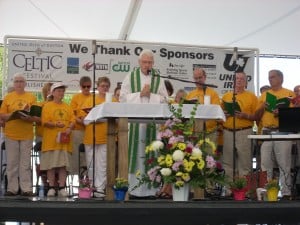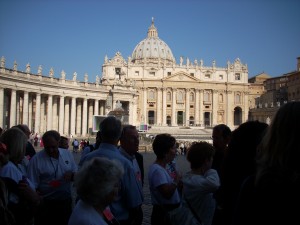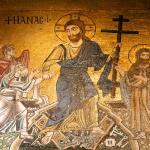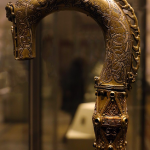Two weeks ago, in the New York Times, Ross Douthat stirred up a bit of an ecclesial ruckus by asking “Can liberal Christianity be saved?” Douthat was moved to ask by viewing the news out of the then recently concluded General Convention of the Episcopal Church—news that confirmed the markedly liberal social and ecclasiastical turn the denomination has taken in recent years—alongside recently released statistics on the precipitous decline of membership, financial support, and active involvement in Episcopal congregations that parallels that sharp left turn in polity.
I thought Douthat made some good points, especially when comparing the Episcopal Church to liberal Catholicism:
As a result, today the Episcopal Church looks roughly how Roman Catholicism would look if Pope Benedict XVI suddenly adopted every reform ever urged on the Vatican by liberal pundits and theologians. It still has priests and bishops, altars and stained-glass windows. But it is flexible to the point of indifference on dogma, friendly to sexual liberation in almost every form, willing to blend Christianity with other faiths, and eager to downplay theology entirely in favor of secular political causes.
Unfortunately, his good points were swiftly buried under a deluge of combox bombs and retaliatory postings from both liberal Christians (who must have been stung by Douthat’s comparing their ostrich-y denial of the demographics of decline to the dismembered knights of Monty Python & The Holy Grail claiming “It’s just a flesh wound!”) and atheists (who want no religion—especially the conservative Catholicism Douthat practices—to be saved, but might make an exception for liberal Christians who demonstrate almost no religion anyway). Most of the reaction devolved into the usual ad hominem slaps at Douthat’s academic credentials, writing style, and facial hair. Which is too bad, because his best point of all, it seems to me, got completely lost.
Douthat was not predicting, and still less hoping for, the disappearance of liberal Christianity, which has added so much to the spread of the Gospel and the work of justice around the world. Instead, he hopes for its redemption:
The defining idea of liberal Christianity — that faith should spur social reform as well as personal conversion — has been an immensely positive force in our national life. No one should wish for its extinction, or for a world where Christianity becomes the exclusive property of the political right.
What should be wished for, instead, is that liberal Christianity recovers a religious reason for its own existence.
I didn’t respond to Douthat’s column two weeks ago, but I’m moved to ask my own question by two pieces of “news” (features with a clear editorial bias) I ran into this weekend. One was an NPR All Things Considered Weekend report on the trend away from formal religion in general in the United States, into which was sandwiched a gloom-and-doom report on Catholicism in the form of a conversation with National Catholic Reporter editor-at-large Tom Roberts. The other was Sunday’s NY Times story by Laurie Goodstein (h/t Fr Jim Martin) entitled “Nuns weigh response to scathing Vatican rebuke.”
The premise of both—that the Church will not survive unless it rejects recent pendulum swings toward conservatism by Church leaders and becomes more accommodating to the world—has been accorded the status of canonical gospel by the media and by many Catholics, both public and private. The received narrative paints a Church disproportionately and irreconcilably divided between The People, a vast international sea of those who reject doctrinal pronouncements, tradition, and authority in favor of relevance, inclusivity, and individual conscience, and The Bishops (among whom the Pope is just one of the boys), a tiny aged and withering cabal of whited sepulchers fanatically and fruitlessly clinging to the power to hate, oppress, abuse, and impoverish Christ’s true followers. It’s Jesus v Pharisees all over again, they want us to believe.
In the NPR piece, reporter Guy Raz gives the Reporter’s Tom Roberts a chance to quote an unnamed young Catholic summing up liberal Catholics’ indictment of The Bishops:
RAZ: In an article, you quoted a young Catholic 20-year-old. He said, you know, the church since my childhood has felt like a faith rooted in sincere virtue represented by a junta rooted in insincere vice.
ROBERTS: A junta, yeah. It’s a severe judgment of an institution that has not acted the way it says it should and the way it demands of everyone else.
The NY Times quotes Sr Pat Farrell, President of the Leadership Conference of Women Religious and anointed representative of The People, on what “real obedience” means, clearly accepting the LCWR’s view that it does not have anything at all to do with smart women listening to the direction of unenlightened men.
“We have a differing perspective on obedience,” Sister Farrell said. “Our understanding is that we need to continue to respond to the signs of the times, and the new questions and issues that arise in the complexities of modern life are not something we see as a threat.”
These same conflicts are gripping the Catholic Church at large. Nearly 50 years after the start of Vatican II, which was intended to open the church to the modern world and respond to the “signs of the times,” the church is gravely polarized between a progressive wing still eager for change and reform and a traditionalist flank focused on returning to what it sees as doctrinal fundamentals.

Both of these pieces riled me enough to get me talking back to the car radio and the laptop. Both of them begged fisking, though my skills at that are nowhere near Ross Douthat’s or his commenters’, and fisking doesn’t really accomplish much in most cases beyond making the fisker feel slightly less like throwing the laptop across the room. I didn’t, in any case, have time, because I wanted to squeeze room into the weekend’s dudgeon for the annual Gaelic Mass celebrated as part of the Dayton Celtic Festival. And while I was there, with a thousand or more others in the riverside peace of a Sunday morning—hearing the readings in Irish and singing the praises of Our Lady of Knock, worshiping under a big tent with a communion of saints that included kilted men and tattooed lasses, Knights of Columbus in plumes and babies in sunsuits and homeless people and veiled women from the Tridentine parish, an ASL interpreter signing the Irish Blessing and lovely young people dancing a hornpipe to Jesu, Joy as an Offertory—somehow my rile just ebbed away.
Because this is the Church: one, holy, catholic and apostolic, and in no danger—never in any danger, we are promised—of being prevailed upon by the gates of hell. Every day, in every corner of the world, the vast majority of Catholics go about their lives as they always have and always will, living their faith to the best of their ability and to the full extent of their love for Christ and his Church.
They—we—are not interested in juntas or headlines. We are conservatives and liberals and everything in between, though few of us bother with labels. We are daily communicants and Christmas-and-Easter Catholics, guitar strummers and chanters Gregorian, piners after “And also with you” and speakers of Et cum spiritu tuo. Those of us in the US may shake our heads occasionally at the drop in weekly attendance, but those of us elsewhere—like the parishioners of my Ugandan friend Fr Simon Wankya, whose territory is so vast that he can only celebrate Mass two or three times a year at each of its many station churches, rattling in over the unpaved roads on his donated motorbike to be swarmed by thousands of chanting, dancing, joyful Catholics—have no idea what we are so worried about. We are privileged and persecuted, deeply involved in the world and profoundly countercultural.
We are women who share our gifts of leadership and prophetic witness and Gospel proclamation and healing with the Church and the world and have long since made peace with (or never questioned in the first place) an all-male priesthood. We are married and single and widowed and divorced and every initial of LGBT and we make our daily and difficult peace with the call to chastity, and living the gift of our sexuality in the way God has given us to live it and with the grace God gives us to do it is not always (and sometimes not ever) the first thing we think about when we identify ourselves as human. We are people of deep generosity; we care for the least among us—our hurting neighbors around the world, next door, in our own homes—without stint or question, and most of us wouldn’t even recognize that we are doing social justice when we do. We are men—laymen and deacons, presbyters and bishops—who have never oppressed or abused or wrangled for power or greed, who live and serve and love in humility and even in reparation for the evil done in our name.
In his conversation with NPR’s Guy Raz, Tom Roberts (sounding fairly illiberal, surprisingly) laments the demise of the Church as he knows it.
RAZ: And in that future, the sort of the stereotype of these sort of Irish-American silver-haired priest or the Italian-American priest, that probably is not going to be the future either. I mean, presumably, the growth is going to be coming from Spanish-speaking communities.
ROBERTS: Yes. And all of those old anchor images, all of those old, you know, givens that I grew up with in my years of Catholics in the ’50s and ’60s, you can eliminate that. It’s not going to be the same. There are 30,000, for instance, lay ministers who are being paid to do ministry in a Catholic Church today. That didn’t exist 50 years ago.
So the seismic shifts, the changes that we’re sort of in the midst of, and sometimes we don’t recognize because we’re right in the middle of it all as it’s going on, I think are significant. Where they lead, we’re not certain, but things are changing rather dramatically.
“It’s not going to be the same.” Well, there’s a place we can agree. The New York Times will not be the final word on whether, and how, the Catholic Church survives. Neither will NPR, or the LCWR, or Ross Douthat or his critics, or the National Catholic Reporter (or the National Catholic Register, for that matter). But we don’t need them to be. All we have to do is look around, at a Celtic Mass or a parish council meeting or Christmas Eve in the Vatican or a Men’s Fellowship bowling night or a youth mission trip or an International Eucharistic Congress. We’re here, we’re queerly impossible to reduce to a set of memes, get used to us.
We’re Catholics. It’s never Jesus v Pharisees, it’s us v our own forgetfulness of who we are. And whether “the liberal wing” recalls it in time for a deathbed conversion or not, we don’t just have what Douthat calls “a religious reason for existence.” Our existence, individually and as a Church, is inseparable from our religion. As they say in Irish, Buíochas le Dia—Thanks be to God.
















